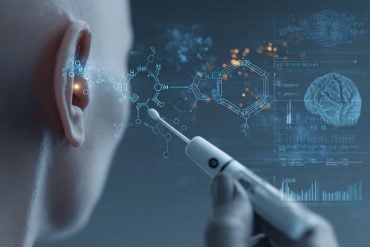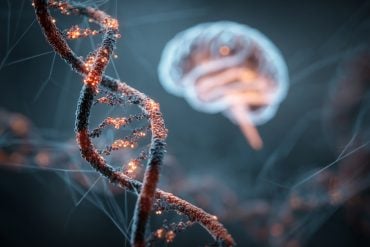Summary: Researcher report long-lasting proteins in the brain could be a crucial part of the molecular machinery that helps govern long term memory and learning.
Source: Johns Hopkins Medicine.
In the tiny brain space where two nerve cells meet, chemical and electric signals shuttle back and forth, a messaging system that ebbs and flows in those synaptic spaces, sometimes in ways that scientists believe aid and abet learning and memory. But because most of the proteins found in those synapses die and renew themselves so rapidly, scientists have had a hard time pinning down how synapses are stable enough to explain the kind of learning and memory that lasts a lifetime.
Now, Johns Hopkins neuroscientists report success in using large-scale studies of proteins and high-tech chemical analysis to discover 164 proteins within synapses in mice that outlast neighboring proteins by weeks and months. These stable proteins, they say, may be part of the molecular machinery that governs long-term memory and learning—as well as loss of memory—in all mammals, including humans. A summary of their experiments is published the week of April 2 in the Proceedings of the National Academy of Sciences.
“We knew that the overall structure of synapses tends to be very stable, lasting at least a year in the brains of rats,” says Richard Huganir, Ph.D., professor and director of the Solomon H. Snyder Department of Neuroscience and director of the Kavli Neuroscience Discovery Institute at the Johns Hopkins University School of Medicine.
His team also knew of long-lasting proteins such as crystallin, which makes up the lens of the eye, and collagen, found in connective tissue. Proteins within nuclear pores, the transport tunnels in and out of a cell’s nucleus, and histones, a kind of “spool” that DNA winds around, also are very stable.
“So, we reasoned, there must be proteins in those synapses that are long-lasting, too, and we believe we have found a lot of them.”
To do so, Huganir and his colleagues focused on a group of eight mice bred in the laboratory and fed with chow that contained a molecular tracer able to glom onto the animals’ proteins.
The tracer was an organic compound called an amino acid, the building blocks of proteins. But these amino acids contained extra neutrons, which would make the protein “heavier” when analyzed by a mass spectrometer, a device that measures the mass and charge of molecules.
The mice ate the food with “heavy” amino acids for seven weeks. During this period, long-lasting proteins tended to incorporate the heavy tracer at a slower rate than more short-lived proteins.
Then the mice received another seven weeks of food that contained “light” amino acids lacking the extra proton. Long-lived proteins turnover less frequently, and thus hang on to the heavy tracer.
The scientists then analyzed brain tissue from two of the mice after the first seven weeks and two more mice after another seven weeks. They also put four of the mice into larger cages with tubes, beads and other objects to stimulate their brain activity and analyzed brain tissue from two of them after each seven-week period.

Using a mass spectrometer, the scientists recorded the ratio of heavy to normal amino acids on 2,272 proteins located within synapses. Long-lived proteins retained more than half of the heavy amino acids during the first seven-week period.
Most of the proteins were short-lived, lasting a day or two, says Huganir. But, the scientists found 164 proteins that lasted much longer—up to several weeks or months. Some are estimated to last for years.
Working with Akhilesh Pandey, M.D., Ph.D., at the Johns Hopkins McKusick/Nathans Institute of Genetic Medicine, the research team next isolated and identified the long-lasting proteins. One of them belongs to the RAS signaling pathway, and others are linked with cellular scaffolding.
Huganir and his team are continuing to study 50 of the most long-lived proteins among the group, some of which are estimated to last for years. As these “old” proteins can accumulate damage over time, he says his team will also be looking for any connections between the proteins and human age-related cognitive decline.
Scientists Seok Heo, Graham H. Diering, Chan Hyun Na, Raja Sekhar Nirujogi and Julia L. Bachman also contributed to the research.
Funding: Funding for the research was provided by the National Institutes of Health (P50MH100024, R01NS036715 and S10OD021844), the Center for Proteomics Discovery at the Johns Hopkins University School of Medicine and the Canadian Institute for Health Research.
Source: Vanessa Wasta – Johns Hopkins Medicine
Publisher: Organized by NeuroscienceNews.com.
Image Source: NeuroscienceNews.com image is credited to Johns Hopkins Medicine.
Original Research: Abstract for “Identification of long-lived synaptic proteins by proteomic analysis of synaptosome protein turnover” by Seok Heo, Graham H. Diering, Chan Hyun Na, Raja Sekhar Nirujogi, Julia L. Bachman, Akhilesh Pandey and Richard L. Huganir in PNAS. Published February 15 2018.
doi:10.1073/pnas.1720956115
[cbtabs][cbtab title=”MLA”]Johns Hopkins Medicine “Long-Lasting Brain Proteins Offer Clues to How Memories Last a Lifetime.” NeuroscienceNews. NeuroscienceNews, 1 April 2018.
<https://neurosciencenews.com/memory-brain-protein-8723/>.[/cbtab][cbtab title=”APA”]Johns Hopkins Medicine (2018, April 1). Long-Lasting Brain Proteins Offer Clues to How Memories Last a Lifetime. NeuroscienceNews. Retrieved April 1, 2018 from https://neurosciencenews.com/memory-brain-protein-8723/[/cbtab][cbtab title=”Chicago”]Johns Hopkins Medicine “Long-Lasting Brain Proteins Offer Clues to How Memories Last a Lifetime.” https://neurosciencenews.com/memory-brain-protein-8723/ (accessed April 1, 2018).[/cbtab][/cbtabs]
Abstract
Identification of long-lived synaptic proteins by proteomic analysis of synaptosome protein turnover
Memory formation is believed to result from changes in synapse strength and structure. While memories may persist for the lifetime of an organism, the proteins and lipids that make up synapses undergo constant turnover with lifetimes from minutes to days. The molecular basis for memory maintenance may rely on a subset of long-lived proteins (LLPs). While it is known that LLPs exist, whether such proteins are present at synapses is unknown. We performed an unbiased screen using metabolic pulse-chase labeling in vivo in mice and in vitro in cultured neurons combined with quantitative proteomics. We identified synaptic LLPs with half-lives of several months or longer. Proteins in synaptic fractions generally exhibited longer lifetimes than proteins in cytosolic fractions. Protein turnover was sensitive to pharmacological manipulations of activity in neuronal cultures or in mice exposed to an enriched environment. We show that synapses contain LLPs that may underlie stabile long-lasting changes in synaptic structure and function.






